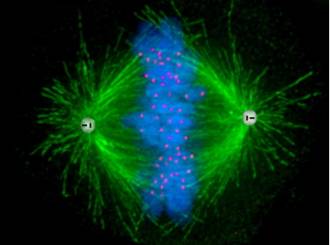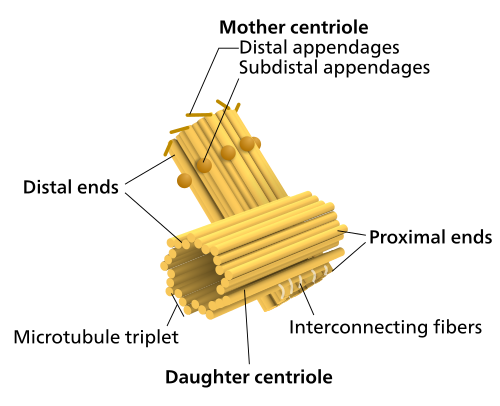Centrosomes
Online Biology Dictionary
|
|
 Dividing human cell: The centrosomes are shown as gray circles, the chromosomes are in blue, the kinetochores in pink, and the spindle apparatus in green (hairlike strands are microtubules).
Dividing human cell: The centrosomes are shown as gray circles, the chromosomes are in blue, the kinetochores in pink, and the spindle apparatus in green (hairlike strands are microtubules). Components of a centrosome (Image: Wikimedia)
Components of a centrosome (Image: Wikimedia)
In dividing animal cells, most microtubules spread out from regions known as centrosomes (/SEHN-trə-sōmz/), which are also known as microtubule-organizing centers (MTOCs). They play a crucial role in mitosis and meiosis. During prophase, the centrosomes migrate to opposite ends of the cell as it prepares to divide.
A centrosome is composed of two centrioles (see figure right), which lie at right angles to each other. Each centrosome is embedded in a condensed mass of proteins. When a cell is not undergoing division, a single centrosome is present. However, when the cell does begin to divide, both in mitosis and meiosis, the centrosome replicates early in the process. The spindle apparatus begins to form. Each centrosome serves as a center of organization for the microtubules of half the spindle.
The cells of plants and fungi do not have centrosomes (there are certain exceptions). Instead, other types of structures are responsible for organizing the microtubules.
Most shared on Macroevolution.net:
Human Origins: Are we hybrids?
On the Origins of New Forms of Life
Mammalian Hybrids
Cat-rabbit Hybrids: Fact or fiction?
Famous Biologists
Dog-cow Hybrids
Georges Cuvier: A Biography
Prothero: A Rebuttal
Branches of Biology
Dog-fox Hybrids